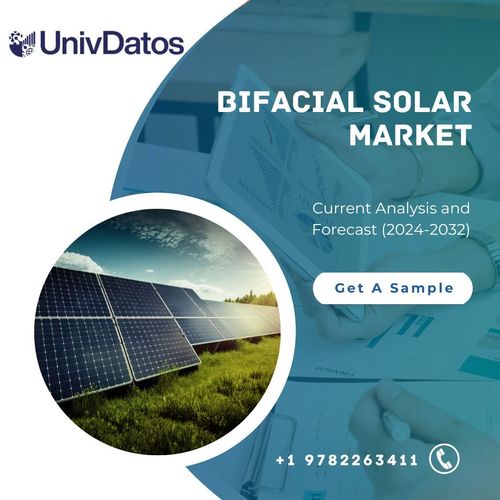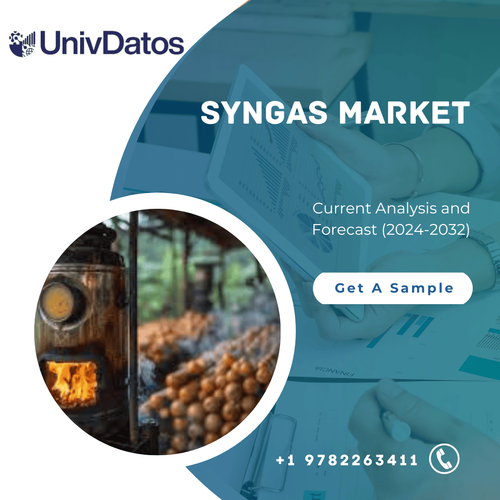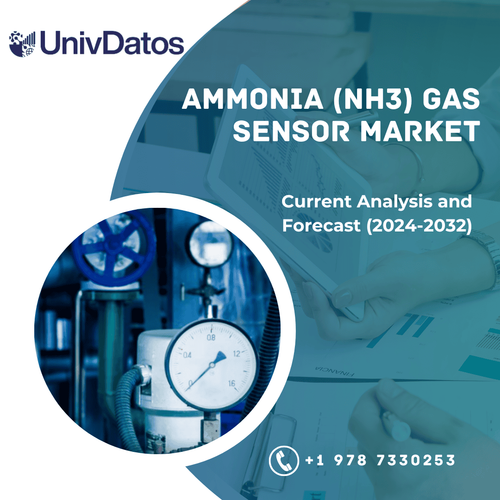Ozone Generation Market: Current Analysis and Forecast (2023-2030)
Emphasis on Technology (Ultraviolet, Cold Plasma, and Corona Discharge & Electrolytic); Application (Wastewater Treatment, Air Purification, Food and Beverage, and Medical Equipment); End User (Industrial, Residential, and Municipal); and Region/Country
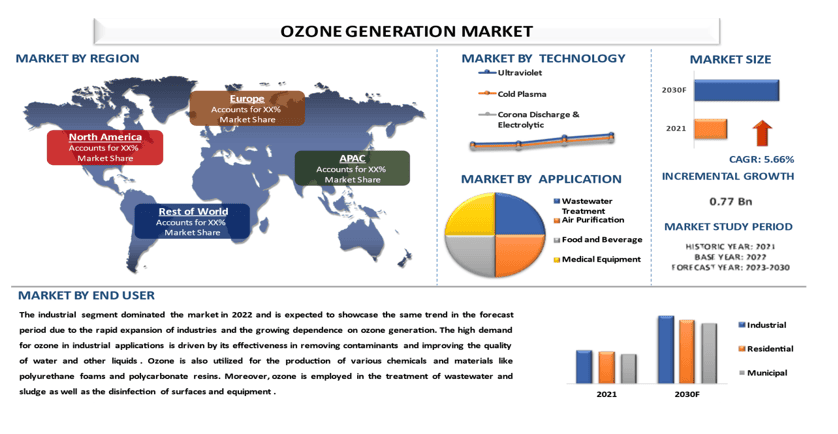
The Ozone Generation Market is expected to reach USD 2.17 Billion in 2030 by growing at a CAGR of 5.66% during the forecast period 2023-2030. due to the growing use of ozone in medical applications. The utilization of ozone in medicinal applications, including the disinfection of equipment and surfaces, the treatment of wounds and burns, and the management of chronic disorders such as arthritis and diabetes, has led to a rise in the demand for ozone generation technology, driving the expansion of the ozone generation market. For instance, the Ozone-X system developed by the company Ozone-X, Inc. uses ozone to disinfect surfaces and equipment in hospitals and healthcare facilities and has been shown to be effective against a wide range of pathogens, including MRSA and norovirus. Moreover, the utilization of ozone for medicinal purposes is increasing in prevalence, with one such example being its use in the treatment of wounds and burns. Research has demonstrated that ozone possesses antimicrobial and anti-inflammatory properties, thus making it an ideal therapeutic option. Ozone Therapy International has engineered a device that has been implemented in numerous medical establishments globally, to treat wounds and burn injuries.
Some of the major players operating in the market include Daikin Industries, Ltd., Fuji Electric Co., Ltd., Evoqua Water Technologies LLC, Ebara Corporation, Mitsubishi Electric Corporation, MKS Instruments, Toshiba Corporation, XyleM, Teledyne Technologies, and Electrolux. Several M&As along with partnerships have been undertaken by these players to facilitate customers with hi-tech and innovative products/technologies.
Insights Presented in the Report
“Amongst technology, the corona discharge & electrolytic segment dominated the market in 2022.”
Based on technology, the market is divided into ultraviolet, cold plasma, corona discharge & electrolytic. The corona discharge & electrolytic segment dominated the market in 2022 and is expected to show the same fashion in the forecast period. The corona discharge method has the highest ozone productivity, it is used for this research with dielectric barrier discharges. The corona discharge method of ozone production has seen an increase in demand due to its ability to generate higher concentrations and larger volumes of ozone than the ultraviolet method. These higher ozone levels are beneficial in water treatment, food processing, and medical sterilization applications. Additionally, the Corona Discharge Method is advantageous due to its flexibility in ozone concentration control. By adjusting the discharge voltage and frequency, users can modify the ozone output to fulfill specific requirements. This capability renders it an ideal selection for applications requiring accurate ozone dosing, such as swimming pool water treatment and air purification systems.
“Amongst applications, the medical equipment segment generated the highest revenue in 2022.”
Based on application, the market is categorized into wastewater treatment, air purification, food and beverage, and medical equipment. The medical equipment segment generated the highest revenue in 2022 and is expected to showcase the same trend in the forecast period due to the increased utilization for sterilization purposes. Ozone is an effective antimicrobial agent, capable of killing bacteria, viruses, and other pathogens, making it ideal for the sterilization of medical instruments, equipment, and surfaces. The advantages of ozone in this context include its broad-spectrum efficacy, its ability to penetrate inaccessible areas, and its rapid action. With the advancement of technology, efforts are being undertaken to enhance the efficacy and safety of ozone sterilization processes, to create compact and portable ozone generators, and to implement ozone monitoring and control systems in medical equipment.
“North America was the largest market for ozone generations market in 2022.”
The North American ozone generation market dominates the market and is expected to behave in the same fashion in the forecast period due to strict environmental restrictions regarding water and air quality, especially in the United States and Canada. The high demand for ozone generation in North America is largely attributed to its efficacy in removing contaminants and improving water quality, as well as its applicability to a variety of water sources, including drinking water, wastewater, and industrial effluent. This demand is further fueled by the presence of industries such as agriculture, mining, and manufacturing, which require ozone generation technology to fulfill their water treatment needs. Additionally, technological advancements in North America, such as the development of novel and more effective ozone generators, advanced sensors and control systems, and portable ozone generators, have been driving the demand for this technology.
Q1: What is the current market size and growth potential of the global ozone generation market?
Ans: The global ozone generation market was valued at USD 1.4 billion in 2022 and is expected to grow at a CAGR of 5.66% during the forecast period (2023-2030).
Q2: What are the driving factors for the growth of the global ozone generation Market?
Ans: The major factors contributing to the growth of the market include the increasing demand for water and air purification, the increasing use of ozone in industrial processes, and the growing use of ozone in medical applications.
Q3: Which segment has the largest share of the global ozone generation market by Technology?
Ans: The corona discharge & electrolytic segment has the largest share of the global ozone generation market.
Q4: What are the emerging technologies and trends in the global ozone generation market?
Ans: Hybrid ozone-UV systems are the latest trends in the global ozone generation market.
Q5: Which region will dominate the global ozone generation market?
Ans: North America is expected to dominate the market during the forecast period.
Q6: Who are the key players operating in the global ozone generation market?
Ans: Daikin Industries, Ltd., Fuji Electric Co., Ltd., Evoqua Water Technologies LLC, Ebara Corporation, Mitsubishi Electric Corporation, MKS Instruments, Toshiba Corporation, XyleM, Teledyne Technologies, and Electrolux.
Ozone Generation Market Report Coverage
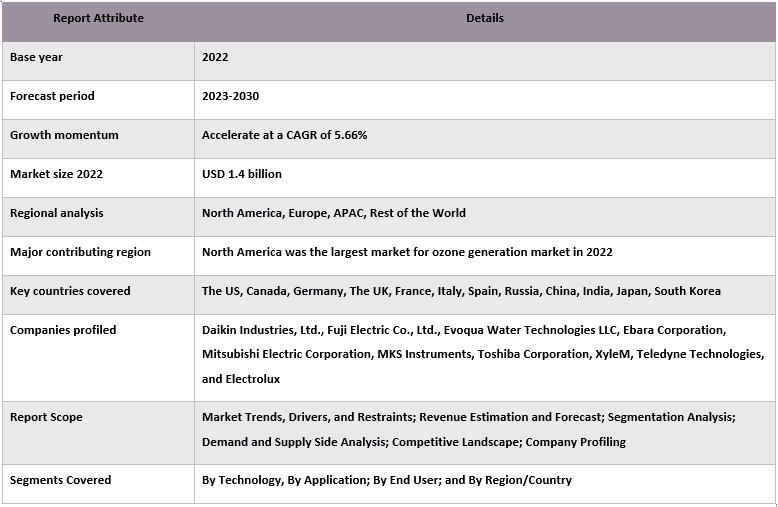
Reasons to buy this report:
- The study includes market sizing and forecasting analysis validated by authenticated key industry experts.
- The report presents a quick review of overall industry performance at one glance.
- The report covers an in-depth analysis of prominent industry peers with a primary focus on key business financials, product portfolios, expansion strategies, and recent developments.
- Detailed examination of drivers, restraints, key trends, and opportunities prevailing in the industry.
- The study comprehensively covers the market across different segments.
- Deep dive regional level analysis of the industry.
Customization Options:
The global ozone generation market can further be customized as per the requirement or any other market segment. Besides this, UMI understands that you may have your own business needs, hence feel free to contact us to get a report that completely suits your requirements.
Table of Contents
Research Methodology for the Ozone Generation Market Analysis (2023-2030)
Analyzing the historical market, estimating the current market, and forecasting the future market of the global ozone generation market were the three major steps undertaken to create and analyze the adoption of ozone generation in major regions globally. Exhaustive secondary research was conducted to collect the historical market numbers and estimate the current market size. Secondly, to validate these insights, numerous findings and assumptions were taken into consideration. Moreover, exhaustive primary interviews were also conducted, with industry experts across the value chain of the global ozone generation market. Post assumption and validation of market numbers through primary interviews, we employed a top-down/bottom-up approach to forecasting the complete market size. Thereafter, market breakdown and data triangulation methods were adopted to estimate and analyze the market size of segments and sub-segments of the industry pertains to. Detailed methodology is explained below:
Analysis of Historical Market Size
Step 1: In-Depth Study of Secondary Sources:
A detailed secondary study was conducted to obtain the historical market size of the ozone generation market through company internal sources such as annual reports & financial statements, performance presentations, press releases, etc., and external sources including journals, news & articles, government publications, competitor publications, sector reports, third-party database, and other credible publications.
Step 2: Market Segmentation:
After obtaining the historical market size of the ozone generation market, we conducted a detailed secondary analysis to gather historical market insights and share for different segments & sub-segments for major regions. Major segments are included in the report as technology, application, and end-user. Further country-level analyses were conducted to evaluate the overall adoption of testing models in that region.
Step 3: Factor Analysis:
After acquiring the historical market size of different segments and sub-segments, we conducted a detailed factor analysis to estimate the current market size of the ozone generation market. Further, we conducted factor analysis using dependent and independent variables such as the technology, application, and end-user of the ozone generation market. A thorough analysis was conducted of demand and supply-side scenarios considering top partnerships, mergers and acquisitions, business expansion, and product launches in the ozone generation market sector across the globe.
Current Market Size Estimate & Forecast
Current Market Sizing: Based on actionable insights from the above 3 steps, we arrived at the current market size, key players in the global ozone generation market, and market shares of the segments. All the required percentage shares split and market breakdowns were determined using the above-mentioned secondary approach and were verified through primary interviews.
Estimation & Forecasting: For market estimation and forecast, weights were assigned to different factors including drivers & trends, restraints, and opportunities available for the stakeholders. After analyzing these factors, relevant forecasting techniques i.e., the top-down/bottom-up approach were applied to arrive at the market forecast for 2030 for different segments and sub-segments across the major markets globally. The research methodology adopted to estimate the market size encompasses:
- The industry’s market size, in terms of revenue (USD) and the adoption rate of the ozone generation market across the major markets domestically.
- All percentage shares, splits, and breakdowns of market segments and sub-segments.
- Key players in the global ozone generation market in terms of products offered. Also, the growth strategies adopted by these players to compete in the fast-growing market.
Market Size and Share Validation
Primary Research: In-depth interviews were conducted with the Key Opinion Leaders (KOLs) including Top Level Executives (CXO/VPs, Sales Head, Marketing Head, Operational Head, Regional Head, Country Head, etc.) across major regions. Primary research findings were then summarized, and statistical analysis was performed to prove the stated hypothesis. Inputs from primary research were consolidated with secondary findings, hence turning information into actionable insights.
Split of Primary Participants in Different Regions
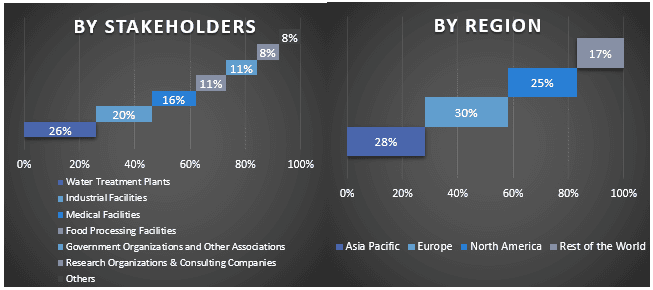
Market Engineering
The data triangulation technique was employed to complete the overall market estimation and to arrive at precise statistical numbers for each segment and sub-segment of the global ozone generation market, data was split into several segments & sub-segments after studying various parameters and trends in the areas of technology, application, and end-user in the global ozone generation market.
The main objective of the Ozone Generation Market Study
The current & future market trends of the global ozone generation market were pinpointed in the study. Investors can gain strategic insights to base their discretion for investments on the qualitative and quantitative analysis performed in the study. Current and future market trends determined the overall attractiveness of the market at a regional level, providing a platform for the industrial participant to exploit the untapped market to benefit from a first-mover advantage. Other quantitative goals of the studies include:
- Analyze the current and forecast market size of the ozone generation market in terms of value (USD). Also, analyze the current and forecast market size of different segments and sub-segments.
- Segments in the study include areas of technology, application, and end-user.
- Define and analyze the regulatory framework for the ozone generation
- Analyze the value chain involved with the presence of various intermediaries, along with analyzing customer and competitor behaviors of the industry.
- Analyze the current and forecast market size of the ozone generation market for the major region.
- Major countries of regions studied in the report include Asia Pacific, Europe, North America, and the Rest of the World
- Company profile of the ozone generation market and the growth strategies adopted by the market players to sustain in the fast-growing market.
- Deep dive regional level analysis of the industry
Related Reports
Customers who bought this item also bought


